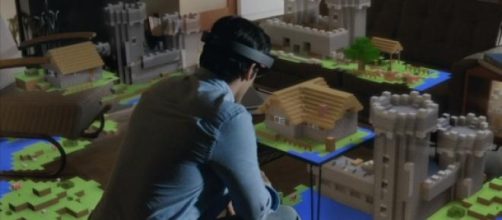If you didn't get a chance to snatch a pair of those $1,500 Google Glasses, fear not: Microsoft has got you covered. The Redmond-based company just revealed a new device that will change the way people interact with computers and gadgets. And this time it is for real: the new HoloLens, an augmented reality headset that allows you to see and interact with holograms, will be available for consumers next Fall.
"This is your world with holograms", said Microsoft's Alex Kipman, during the Windows 10 launch event. "Holograms can take part of our daily life", he promised.
The demo Microsoft showed on stage was pretty enticing. "Oculus, Magic Leap, Glass developers and everyone else, we humbly invite you. Come create holograms with us", Kipman added.
He called HoloLens "the most advanced holographic computer the world has ever seen", with a third holographic processing unit, alongside the built-in CPU and GPU. That obviously means no connection with PC will be needed.
Microsoft's answer to Google Glass will be launched at about the same time as Windows 10, probably October. The next version of the most used desktop operating system on the planet is packed with new features and is set to conquer the hearts of consumers - or so the company expects.
"We want to move from people needing Windows, to choosing Windows, to loving Windows", said Microsoft CEO Satya Nadella, during a press event held yesterday at the company's headquarters, in Redmond.
"Windows 10 is built for a world where there are going to be more mobile devices than people", he said.
Among the new features, Windows 10 will have a new browser - which means Microsoft is effectively killing Internet Explorer. "Project Spartan", as executive Joe Belfiore explained, has a streamlined design and allows offline reading. It also integrates Cortana, Microsoft's answer to Siri and Google Now, which will be available everywhere in Windows 10: the phone, the browser, and the desktop.
"It is very telling that Microsoft is concentrating a lot on experiences", says Gartner's distinguished analyst Michael A. Silver, who specialises in operating systems and Office. "Windows 10 has a lot of interesting stuff.
It's one of the most visionary announcements Microsoft has made in a very long time", he tells me, after attending the event at Microsoft's headquarters.
With Windows 10, Microsoft hopes to lure millions of customers who are still using Windows 7 or even Windows XP, the 14 year-old OS that it's not even supported anymore. The company will make Windows 10 free of charge for all Windows 8 and Windows 8.1 users, and free for Windows 7 users during the first year. The move follows the lead of Apple, that made Mac OS X Yosemite available for free last fall, but there's a fundamental difference between the two companies: Apple is in the business of selling the machines that run Mac OS. Microsoft is not.
That doesn't mean hardware isn't important to the Redmond company. In fact, they also announced a new Surface tablet yesterday, but this time aiming directly at big businesses. The Surface Hub is a huge wall tablet, with an 84-inch touch screen, meant to change the way companies collaborate. It's like a super sized brainstorming device. No prices have been revealed, but it's easy to guess both new devices - HoloLens and Surface Hub - will be pricey, at least in the beginning.
This is the new, innovative Microsoft under Satya Nadella. His predecessor, Steve Ballmer, also took a lot of risks, and failed miserably in a dozen of them (Kin smartphones, anyone?). But this time, Microsoft seems to know where it is going, even if Windows 10 still has a long way to go in luring consumers to its mobile offerings. "It´s a big day for Windows", Nadella said. "We want to make Windows 10 the most loved release of Windows." Given how much consumers hated Windows 8, it might not be hard to achieve.

